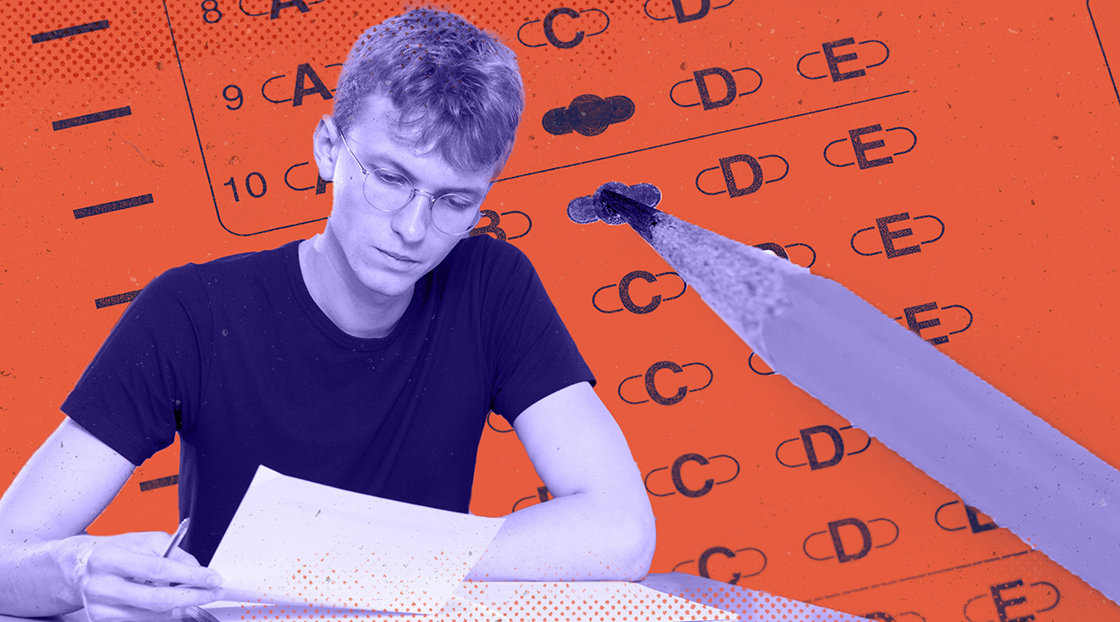The admissions process isn’t what it used to be. Both the COVID-19 pandemic and a change in the culture has led many institutions to rethink how they assess applicants, with many going test-optional or foregoing standardized admissions testing completely .
Historically, standardized admissions testing has been at the heart of the application process. Students traditionally traveled to each institution to take a school-specific admission test, which ended up being cumbersome for both the students and institutions.
“The first challenge that the standardized admission test was intended to solve was how do colleges not have to spend so much time on that admissions process. Can they have a common test that they all agree on?” said David Hawkins, chief education and policy officer at the National Association for College Admission Counseling.
Out of that effort came the College Board and SAT.
“It was a tool to help them remain exclusive,” said Hawkins. “They were designed to pick the crème of the crop.”
However, the state of these tests is now in flux given that many institutions are going test-optional and that a newer test is starting to take hold. Hawkins noted that leading up to the pandemic, approximately 1,000 institutions had already decided to go test-optional.
Test-Optional
Data from June, collected by FairTest The National Center for Fair & Open Testing, indicated more than 1,900 bachelor-degree-granting institutions have ACT/SAT-optional, test-blind or score-free admissions for fall 2023. The number accounts for 83% of four-year institutions. Notably, 78% of the institutions have already extended those policies through fall 2024.
“Admissions offices increasingly recognize that test requirements, given their negative disparate impact on Black and Latinx applicants, are ‘race-conscious’ factors, which can create unfair barriers to access higher education,” FairTest Executive Director Harry Feder said in a June press release. “They also know that standardized exams are, at best, weak predictors of academic success and largely unrelated to college-ready skills and knowledge.”
John Herrmann is executive director of enrollment services at Franciscan University of Steubenville, an Ohio-based private Catholic institution of 3,656 students. He observed that the acceleration to test-optional during the pandemic made the entry requirement to college much easier for students. At this point, he doesn’t see how the metaphorical genie can ever be put back in the bottle.
Schools have historically taught to standardized tests, he said, but they haven’t been doing so as much for the past few years. If universities do decide to start requiring test scores again, he anticipates the transition back will likely be bumpy.
Alternative Metrics
Although some of Franciscan University’s peer institutions are reimplementing test requirements, Herrmann’s institution is not.
“I think that [the reimplementation] will hurt their attractiveness,” he said.
Despite that, 30-40% of applicants are still taking standardized tests. Herrmann’s office has developed workarounds to obtain a robust understanding of applicants who don’t submit test scores.
“We do a lot of data on our students’ GPAs from high school, comparing it to where we think they would have been,” he explained.
The university compares the high school GPAs of students who do take the tests against applicants who only submit a GPA, thus correlating and approximating test scores to GPAs.
“Both subsets are performing at the level we’d expect them to,” said Herrmann. “I don’t think that the high school GPA is an inflated measure.”
Herrmann wonders if the SAT going fully remote might lead to more institutions opting for test-optional admissions.
The pandemic allowed the University of Connecticut, a public institution with 24,076 undergraduates, to reconsider its application and the pieces of information truly relevant to the review process.
“Universities really rethought how they utilize tests in the application review process and some came to the conclusion, UCONN included, that the test can be something that can add value to the application review but it’s not necessarily required for us to make a decision about the admissibility of a student,” said Director of Undergraduate Admissions Vern Granger.
From a student perspective, Granger said the rise of test-optional admissions has reduced a significant cause of stress.
“It allows students to really consider if that test reflects their academic potential and ability, and if they don’t feel it does, there are other pieces of information in the application that they can submit to universities making those decisions,” said Granger.

Equity Concerns
UCONN also considered equity when deciding to remain test-optional. Granger explained that national ACT and SAT data, whether based on race, ethnicity, parental education level or socioeconomic status, points to disparities. In seeking to achieve diverse classes, he said, many institutions saw the requirement of test scores as a barrier.
Hawkins agreed, noting that the tests often amplify the inequities that can be found in the K-12 education system. Specifically, disadvantaged students score lower on tests than their GPAs suggest they should.
Resistance to Test-Optional
At the end of the day, Granger stressed that the decision to go test-optional is one that each institution must make based on its mission and priorities. He pointed to the Massachusetts Institute of Technology’s 2022 decision to reinstate its ACT/SAT requirement.
In an announcement at the time, MIT said, “Our research shows standardized tests help us better assess the academic preparedness of all applicants, and also help us identify socioeconomically disadvantaged students who lack access to advanced coursework or other enrichment opportunities that would otherwise demonstrate their readiness for MIT. We believe a requirement is a more equitable and transparent than a test-optional policy.”
The announcement also noted that standardized tests are not the central focus of its holistic admissions process and that scores are not considered beyond the point where preparedness has been established.
Hawkins pointed to states like Florida, which never went test-optional even during the pandemic, and Tennessee, which recently reinstated its test requirement, as additional examples of resistance to the test-optional movement.
On the other hand, the University of California System went test-blind, meaning that it will not consider SAT or ACT scores when making admissions decisions, in 2021.
No Drop in Quality
Granger agrees with Herrmann that, despite some cases, test-optional is here to stay for the foreseeable future, especially because institutions have continued to admit new classes despite not always having test scores to look at.
Hawkins added that he hasn’t heard institutions that have gone test-optional say that they have experienced a significant drop off in the academic quality of the classes they’re admitting.
“High school grades are significantly more predictive of a student’s ability to succeed at an institution. Test scores might add a bit of predictive power, but institutions all along really had what they needed,” Hawkins said. “It doesn’t surprise me that institutions haven’t really suffered without the test.”
Rise of Alternatives
Recent dismissal of the SAT and ACT has led to alternative testing methods to gauge student readiness for college. Although currently making news, the Classic Learning Test traces its roots back to 2015 when its founder was working as an evening high school teacher in inner city New York.
He realized that his students were disengaged, which he attributed to the utilitarian nature of the American public education system. Standardized testing, he believed, was partially to blame because if it wasn’t on the test, it wasn’t being taught. From there, he set out to develop a test he hoped would provide a more meaningful assessment that would also engage students.
“Unlike SAT and ACT, which are purely achievement-based testing, CLT is both aptitude and achievement-based testing,” said Taryn Boyes, director of marketing for CLT.
She explained that students who attend public school are likely well-prepared to take traditional standardized tests. However, homeschoolers aren’t learning the curriculum the exact same way, which could result in lower ACT or SAT scores.
“Aptitude tests focus on a student’s potential and ability to think critically and problem solve. Instead of being focused on a particular topic, it’s more focused on a student’s ability to think through different types of questions,” said Boyes. “CLT is a great option for students that come from a different type of educational background.”
Classic Learning Test
The CLT consists of 120 questions related to verbal reasoning, grammar and writing and quantitative reasoning. Scores range from 0-120, with no penalty for incorrect answers. It lasts between two hours and two hours and fifteen minutes, without the optional 30-minute essay, and is taken online via remote proctoring.
The content is quite different from traditional standardized tests. Two-thirds of the reading passages are from “classic or great books” that range from antiquity through to the modern era, Boyes said. The passages cover philosophy, religion, science, history and fiction.
The company views the test as presenting all viewpoints. Boyes pointed to the fact that the test’s author bank includes readings from both Karl Marx and C. S. Lewis as proof that it embraces a wide variety of thought.
“We believe that using this variety of texts gives CLT a healthy neutrality on contemporary political matters, which is in contrast to the SAT and ACT which do draw primarily from contemporary sources and tend to favor certain political opinions,” she said. “The CLT is able to engage students with meaningful and enriching texts while ensuring it’s not leaning left or right on the political spectrum.”
Implementation of CLT
The CLT has gained traction, especially with some on the right.
Florida Gov. Ron DeSantis signed a bill into law that made Florida the first state in the nation to fund all school districts to utilize the CLT for 11th graders. The CLT will take effect for rising juniors and seniors for the 2023-24 academic year. As a result, Florida students will be eligible to earn Bright Futures Scholarships with CLT scores.
New College of Florida, a public Sarasota-based liberal arts college of 689 students, announced it would be the first public college in Florida to accept the CLT for admission for the fall 2024 term.
“As New College strives to become a world-class liberal arts educational institution, adding the CLT as an accepted testing option for admissions will ensure we are reaching and welcoming students from all walks of life,” New College Interim President Richard Corcoran said in a press release. “With the growing popularity of the CLT among Florida homeschoolers and classically educated students, we believe this is an exciting step for educational choice and freedom in our state as well.”
CLT in Use
Franciscan University of Steubenville was an early adopter of the CLT and started accepting its scores shortly after the test was developed. The university used the CLT as an alternative to the ACT and SAT when requiring test scores.
The decision to accept the CLT seemed logical for the university’s admissions team, as approximately 20% of the university’s incoming classes are homeschooled.
“It was really hard to gauge necessarily how good or bad these kids are, although we know that homeschool children are typically performing better than our regularly schooled children,” said Herrmann.
The parents of homeschooled children are often the school administrator/superintendent, and they end up writing their child’s transcripts.
“When the CLT came along—and we’re a faith-based liberal arts school—the test is really teaching to what we teach as well with our core curriculum,” Herrmann said. “It overlapped very well with our students and it was the same population of students we were drawing from already.”
He describes the test as a good measure, noting that students who do well on it also tend to do well at the university.
Reluctance to Implement CLT
To date, the CLT has more than 200 partner institutions. Hawkins cautioned that the perceived ideological links the test has could cause it difficulty in gaining widespread acceptance.
“A notion of western learning, of Judeo-Christian values…I don’t know how colleges will respond to it,” Hawkins said.
Granger said his UCONN does not currently accept the CLT and that there hasn’t been a discussion about doing so.
Despite having historically attracted a certain type of student and school, Boyes stressed that the CLT is for all students and schools. The CLT doesn’t employ lobbyists to persuade institutions to accept the test’s scores. However, the company does frequently reach out to institutions to share what it sees as its benefits. It also relies on word-of-mouth referrals from institutions, students and parents. Boyes is hopeful that other states will do like Florida and increase access to the test.
She believes admissions leaders should consider accepting CLT scores because “it offers a better reflection of a student’s true capabilities and potential.” She also advised that by accepting the scores, institutions will be able to attract a more diverse group of applicants, especially homeschoolers.
Another potential headwind, the growing test-optional movement, isn’t a major concern for the company.
“We tell students it never hurts to send your score. In fact, it can only help you,” Boyes said.
Future of Standardized Admission Testing
As a result of the growing acceptance of the test-optional approach, the business model for standardized tests has been undercut.
Testing agencies have embedded themselves in both K-12 systems, through accountability exams and measures of college access, and colleges, through placement exams. Scores are also often used for the allocation of financial aid, such as institutional scholarships and funding associated with the National Merit Scholarship Corporation.
Data from the SAT indicates that test taking hasn’t drastically fallen, regardless of the trend to implement optional and test-blind admissions. In 2022, 1.7 million high school seniors took the SAT at least once, up from 1.5 million in 2021. In a September 2022 press release, the College Board said, “Survey results continue to show more than 80% of students want to be able to send their scores to colleges.”
Test companies are continuing to try to hang on, Hawkins said, by talking to institutions and state-level officials about the perceived benefits of the tests.
“There’s still a very active presence, a marketing and educational presence, of these entities. These agencies have continued to promote their resources as a student lead generation service,” he explained. “Their numbers have declined slightly but they’re still probably the biggest game in town when it comes to names of traditional-aged college students.”







